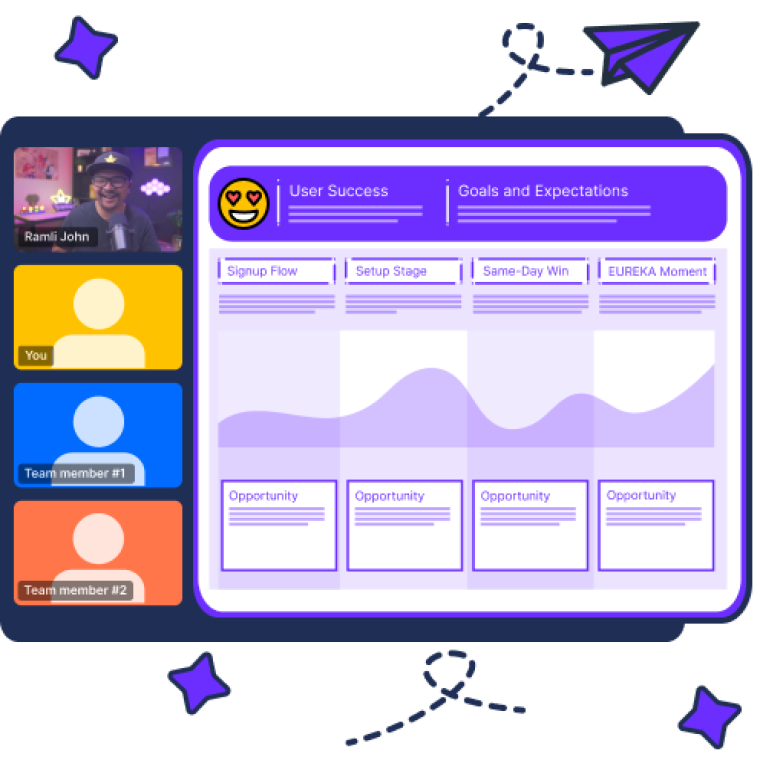Most product teams have too much to do and insufficient time. The natural reaction to that is to create a product roadmap showing the things (they think) they have to do and “prioritize” that roadmap.
Prioritization is more than just deciding what order the items on your roadmap should be in. It’s also deciding what makes it onto the roadmap, and you need guidance for making those decisions. Your product vision can provide that guidance.
Your product vision helps everyone understand the “why” behind your product. When your product vision is clear, it goes a long way toward helping everyone in the organization work toward the common goal of advancing the product in service of this vision. That means it provides guardrails and a basis from which you can say “no.”
Here’s a closer look at how you can use product vision to help you prioritize your roadmap. The result? You’ll have a useful roadmap with the right things in the right order.
How do you understand what to prioritize?
Your product vision is a decision filter to help you understand what to prioritize.
If something advances your product toward your product vision, it's worth further consideration and prioritization. If something doesn’t advance your product toward your product vision, forget about it.
That begs the question, where do those “something’s” come from?
Your roadmap should contain opportunities and problems that you aim to solve, not just features. These opportunities can drive how you decide to revise existing features or add new features.
Pay attention to direct customer feedback to identify opportunities that align with your product vision. Customer feedback also helps you identify problems you can solve to keep your existing customers happy.
Get user feedback with Chameleon
Run in-product surveys to collect contextual user feedback throughout the development process – from ideas to validation to deployment.
Customer reviews, in-app analytics, and support tickets provide clues that help you identify weaknesses with the product. You can also look at usage patterns to identify where your customers run into issues that prevent them from getting the most value out of your product and could drive them away.
Paying attention to this feedback is vital, but don’t automatically put every suggestion you hear on your roadmap. That will slow you down as you try to slog through an overabundance of ideas. You’ll want to treat this information as evidence that feeds your roadmap with potential opportunities and problems worth solving.
Where do organizations struggle?
Most, if not all, organizations talk about prioritization, but several struggle with prioritizing effectively. You can chalk these struggles up to basing prioritization decisions on the wrong information and failing to get support for those prioritization decisions.
Let’s take a closer look at the causes of those struggles.
Not tying decisions to product vision and strategic goals
Organizations make prioritization decisions based on various factors. When those factors don’t tie back to strategic goals, product teams can look busy and produce a lot of outputs, but it’s pure luck if what they produce moves the organization forward.
Some organizations don’t collect data to aid decision-making but, instead, rely on gut instinct to make decisions. This is often the case when the product decision-makers feel they know everything about the customer and don’t seek any additional information. The gut instinct route also happens in immature product organizations.
Other organizations make their decisions based on what appears easy – the so-called “low-hanging fruit.” This approach, also known as a feature factory, is common in organizations focused solely on output.
Both situations are signals that an organization lacks a product vision or is working with a product vision that is not widely understood.
Priorities are driven by the latest sales prospects
Another struggle that organizations have, even if they have a product vision, is that they can’t focus on delivering that vision because they get distracted by requests driven by the sales team.
In B2B and enterprise settings, getting a steady stream of sales requests is common. The sales team might be convinced their requests are essential to winning some big new account, but these can often be things that contradict achieving the product vision.
These requests are difficult to ignore because of the implied impact on organizational revenues. When product teams blindly follow these distractions, they often produce outputs that do not drive the product toward the product vision and end up taking valuable time building features that might only benefit a small subset of customers.
Loud, passionate stakeholders questioning prioritization
A product team can base prioritization decisions on data according to their product vision and still struggle to focus. This often happens when they get hit with loud, passionate requests from stakeholders in the organization. These stakeholders are often executives who argue that a particular feature is essential to the product's success, regardless of whether it is tied to the product vision in any meaningful way.
These requests can lead to outputs that do not move the product toward its vision, or at the very least, distract and slow down the product team.
4 steps to prioritizing your roadmap
To avoid those struggles and create a data-informed product roadmap that helps you realize your product vision, follow these four steps.
1. Gather actionable data
Seek feedback and data from various sources to understand your customers’ problems and why they need them solved.
If introducing a new product, you’ll have to rely on market research and interviews with potential customers and users. Use your research results to identify opportunities where your new product can help customers solve their problems.
If you have an existing product, you can use several additional data sources, including product and usage analytics, in-app surveys, support transcripts, and user surveys. Analyze what you uncover to identify where users get stuck or frustrated, where people aren’t doing what you want them to do, and where you see things that need to be improved.
2. Identify the highest value initiatives
Now that you’ve identified opportunities and problems, the next step is to determine which initiatives are worth working on and dump those that aren’t worth any further effort.
As mentioned above, keep those initiatives that drive your product closer to your vision, and forget those that don’t align with your vision.
Because initiatives can align with your product vision to different extents, it can be helpful to plot them on a matrix that compasses value to effort. The y-axis should represent the extent to which an initiative drives toward your product vision (i.e. the value it delivers). The x-axis should represent the relative effort each initiative takes to implement.
You can use the initiatives’ location on the matrix to decide which ones make sense to do first. The sweet spot would be anything that provides high value and requires low effort. Of course, you won’t always have those initiatives to work. You might then focus on things that provide high value, but require a bit more effort. The key is to always keep value in mind, and do your best to avoid initiatives on the bottom part of the matrix (low value and high effort).

(Source: ProductPlan)
3. Score your initiatives
After your first pass to narrow down the initiatives you’re considering from your roadmap, you’ll want to discuss the remaining initiatives in more detail.
There are a variety of frameworks that your product team can use to figure out the best ideas to pursue first. These frameworks look easy on the surface – just plug a few numbers into a spreadsheet and get a magic number back that tells you the priority.
It can be tempting, but you shouldn’t expect frameworks to provide the perfect answer. They should help guide your discussion and highlight important criteria to consider; chief among them being the relation to product vision and strategic goals.
A good framework to use for that purpose is the IMPACT Prioritization Strategy. IMPACT sets the stage for better prioritization conversations, moving the team past the “why” and focusing on specific trade-offs and expected outcomes.
When you explore your initiatives with IMPACT, you can get more insight into where they fit on your product roadmap.

(Source: ProductPlan)
4. Get stakeholder buy-in on your newly prioritized product roadmap
Putting together a roadmap based on your product vision is one thing. To successfully execute towards your product vision, you need executives and stakeholders to align with that roadmap.
To create that alignment, be transparent about the process you used to create your product roadmap. Give stakeholders access to your roadmap, and provide the data you used to make your decisions. Make it clear how your roadmap decisions tie back to your product vision and strategic goals.
When you share the data and explain how you made decisions, you build credibility. Your stakeholders will see that your roadmap is based on evidence and a structured thought process, rather than gut instinct.
Finally, it’s important to remind your stakeholders that your product roadmap is a plan, not a promise. Set realistic expectations with your stakeholders that things may change as you uncover new information.
Tie your roadmap to your product and organizational vision
Your product roadmap is a tool that helps you communicate what your product strategy is and how you plan to achieve your product vision. To make your roadmap as useful as possible, it should balance the right amount of initiatives and opportunities that you think your team can work towards.
As your team progresses and you learn new things, your roadmap is going to change. To keep your roadmap effective amidst that change, remember to keep your product vision at the forefront of your decision-making.

Weekly advice to make your product stick 💌
Be the first to get the latest product best practices and resources
Prioritize Your Product Roadmap Around Your Product Vision
This article is written by Nick Fields, Product Manager at ProductPlan. Nick is a product person with a passion for embracing new challenges, learning by doing, and always staying curious. He immersed himself in Product Management after five years of establishing and leading a Customer Success team that grew to support 2,000+ customers in the SaaS industry.






